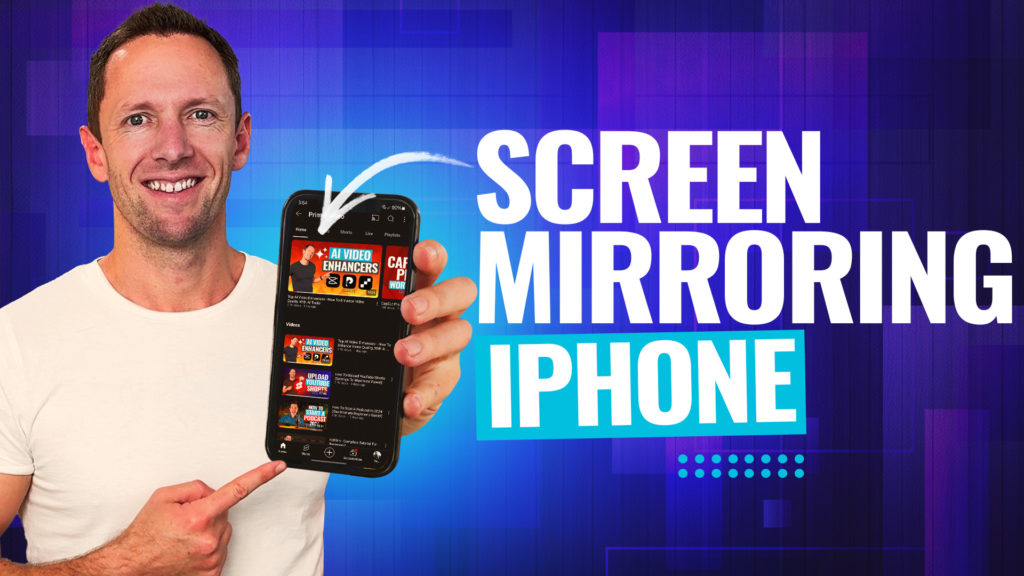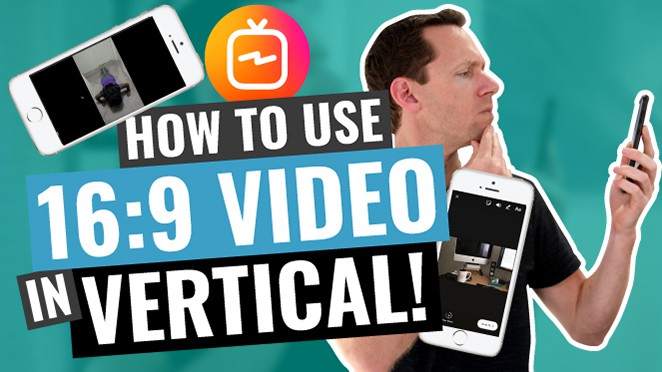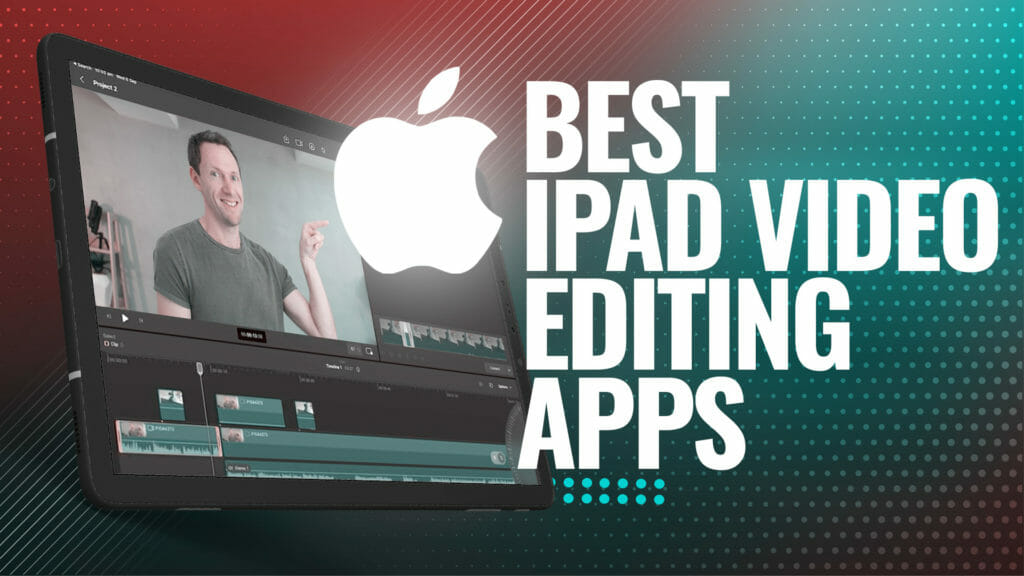If you’re looking for the best email marketing software, Mailchimp and ActiveCampaign would have undoubtedly come up in your search results. They might both be top contenders but how do they perform neck to neck?
In this comprehensive guide you’ll learn how these email marketing platforms stack up when it comes to the key tools and features you need to consider when choosing the right one for your business.
Mailchimp vs ActiveCampaign Overview
Mailchimp has been the go-to email marketing software for a lot of businesses for years. It’s super easy to use with a modern and snappy interface while still offering some impressive tools.
Beginners can dive right in and start creating marketing campaigns straight away. But it’s also scalable and has some more advanced features, meaning even if you have a large business this software could suit your needs as well.
ActiveCampaign is one of the most powerful email marketing tools around. It has pro-level tools, some of which you’ll see in very few other platforms.
These complex features make it harder to jump into for beginners but if you’re serious about email marketing, it might be worth the time. Whether you’re a small or large business, its tools make it possible to optimize your marketing campaigns for maximum results.
So which one is right for you?
Both platforms have their own pros and cons which is why we’ve broken this review down into the key features you should consider.
In each section we’ll provide a detailed comparison of the software so you can decide what’s most important for you.
Feel free to jump to the sections that are most relevant to your business.
Important: When available, we use affiliate links and may earn a commission!
Key email marketing features/aspects we’ll compare:
- Templates & Email Builder
- Marketing Automation
- Segmentation
- Contact Management
- A/B Testing
- Forms & Landing Pages
- Ecommerce
- Integrations
- Reporting & Analytics
- Deliverability
- Other Noteworthy Features
- Customer Support
- Ease Of Use
- Pricing ($USD/monthly)
- Reviewer’s Recommendation
Let’s dive in.
Templates & Email Builder Comparison
The templates and email builder are an important factor in choosing an email marketing tool. You don’t want to be stuck tweaking an unappealing email template using a clunky builder.
The email builder will be assessed based on how flexible it is and how seamlessly it allows you to build out email campaigns. We’ll also look at the quality and customizability of the email templates inside these email marketing services.
Mailchimp Templates & Email Builder
This email builder is fairly simple and easy to use. It has a drag and drop editor that allows you to add the usual blocks into your email.
There’s nowhere near as much flexibility as inside ActiveCampaign. For example, in MC some blocks give you the option to choose between one or two columns but that’s usually just for text blocks. Whereas inside ActiveCampaign you can split a section into numerous columns and insert any variety blocks you like.

MC also doesn’t allow you to adjust the padding on most blocks (only of certain sections e.g. the footer) which further emphasizes the lack of customization available.
There are some cool features such as if you make changes to one text box, you can tick ‘Apply to all existing Text blocks’ and automatically apply that text style to all other blocks of the same type.
There’s also a built-in collaboration feature which is really handy if you’re working in a team. You can send a test email to a collaborator and they can leave comments within the email builder.
One thing that is a bit annoying is that you can’t edit the text directly in an email – it opens up a separate text editor box which takes a second or two to open. This can ruin the flow of creating an email.

There’s a new email builder in beta with requested features like undo/redo and the ability to edit content inside the email itself. The beta version doesn’t have a drag and drop email editor which seems like an interesting choice by Mailchimp. Stay tuned for our updated review when the new editor is released.
There are over 100 designs and templates to choose from. The templates are pretty basic, they’re not jaw-dropping but they’re good enough to get by.
Keep in mind that the Free Plan only comes with basic templates. You have to be on a paid plan to access the layouts and additional pre-built templates.

A feature we love is that it’s really easy to switch between templates. So if you start working on one and decide to change, it will transfer your copy and content block settings to the new templates. This is something you wouldn’t usually see in an email marketing service.
MC also supports custom merge tags which are a super powerful feature. It allows you to insert personalized content across multiple email campaigns or automations and edit that content centrally without having to manually update it everywhere you’ve used it.
There are a number of the more advanced features missing that prove really useful in creating seamless and effective email marketing campaigns. First of all, you can’t easily hide certain blocks on mobile. Most email marketing software makes this super easy so it’s weird that MC doesn’t have a simple way to do this.

Secondly, saved blocks are not supported. This is really helpful when you have content that’s used throughout multiple emails.
Lastly, conditional content can be achieved using custom merge tags or via the Dynamic Content tool. This tool allows you to only show a block to certain recipients who meet a condition. However there’s not a lot of options here (e.g. email address, first name, birthday) so you can’t get overly creative.
There’s an integration with Giphy and Instagram but no stock image library.
Learn more about Mailchimp’s email builder here.
ActiveCampaign Templates & Email Builder
ActiveCampaign’s visual editor offers a ton of flexibility. They recently released a new email editor called the Email Designer.
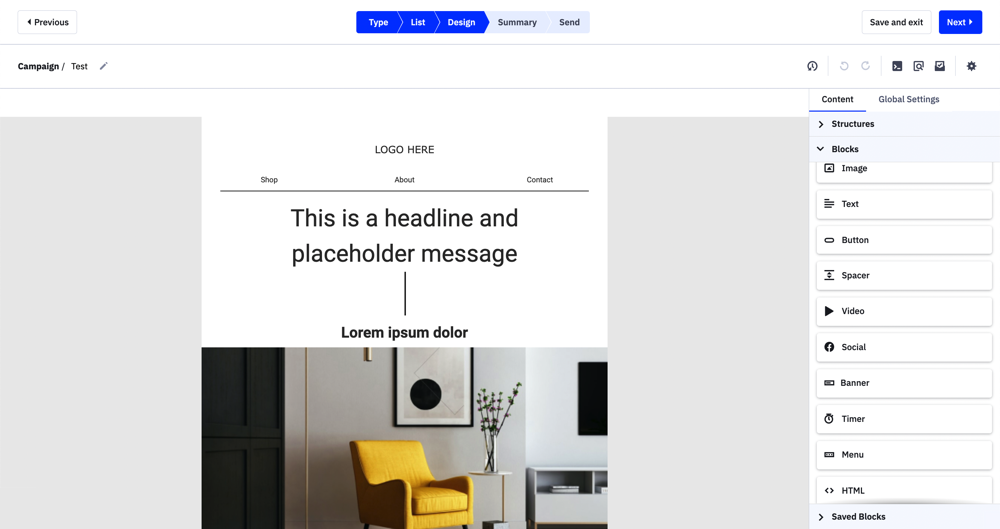
It has a drag and drop editor as well as the ability to add different column structures into your email. You have access to a lot more customizability inside ActiveCampaign than most other email marketing software.
You can edit text directly inside the text boxes which makes it a much more seamless process than in Mailchimp where there’s currently a separate box for writing text.
This editor is great to use and is definitely a step up from their original email builder, the Classic Builder. AC’s Classic Builder offers a ton more customization and features than MC, but it isn’t as seamless as AC’s new Email Builder.
The benefit of AC’s Classic Builder is that it supports A/B testing and conditional content, as their new email builder doesn’t currently support those features. ActiveCampaign has said these features will be added to the new builder soon though.
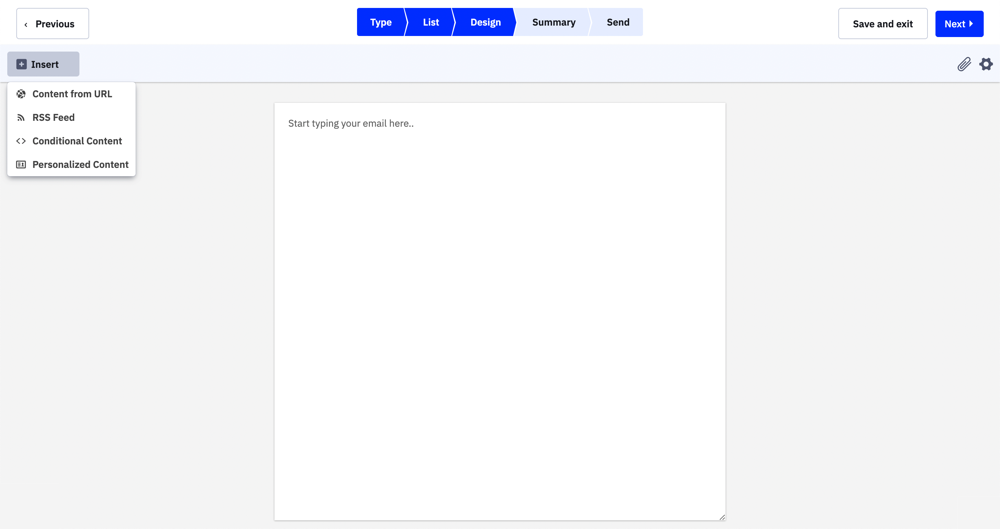
You can hide elements on mobile or desktop with the click of a button and conditional content is supported.
Custom merge tags are also supported. You can learn more about ActiveCampaign’s custom merge tags here.
When it comes to creating text-only emails, the process is much closer to writing a work-style email than inside Mailchimp. While it’s not as quick as something like ConvertKit, it’s still fairly fluid.

The general email campaign section is kind of clunky and the load times can be a bit slow when you’re setting up a broadcast. It doesn’t feel like a snappy process.
There are over 125 email templates with a huge range of basic and designed options available.
There’s no stock image library but some of the templates contain stock images you can use.

The Verdict
ActiveCampaign offers a ton more flexibility and customization options. There are also much more advanced features inside ActiveCampaign. If these things are important to you, AC would suit your needs better.
Mailchimp still has a solid email builder and templates. If you want to create more basic emails and don’t require that higher level of customization, Mailchimp would tick your boxes.
Marketing Automation Comparison
Automating your email marketing campaigns is a great way to grow your business. Each email marketing platform takes a different approach to this and has different marketing automation capabilities.
We’ll assess a range of aspects including how simple it is to create basic and advanced marketing automations on each platform.
Mailchimp Marketing Automation
Sending a broadcast is quick and easy. The interface is modern and load times are speedy. Overall it’s a really pleasant experience.
All automated emails are built using the automation builder, which they call their Customer Journey Builder. This is the new automation builder – the old one (called the Classic Automations) is definitely clunkier and not as seamless.
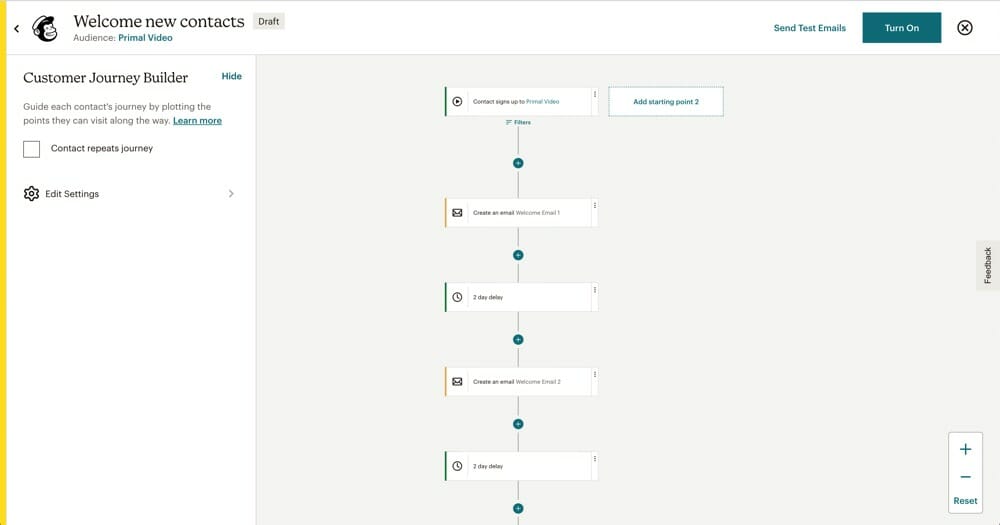
Everything from basic email sequences through to more advanced automations are created and sent via this automation builder.
Basic sequences aren’t as quick as some platforms like ConvertKit but it’s definitely faster than others like GetResponse.
The automation builder is more intuitive and easier to use than AC’s builder but that’s not surprising given it’s a lot more basic.

While you can set up more complex automations in MC, it is missing some of the advanced automation tools that you’ll find in ActiveCampaign.
For example, you can’t start an automation without a starting point which is useful if you only want contacts to enter the automation after completing a different automation. There also aren’t options for setting Goals, webhooks or CRM-related actions within workflows.
However it is still possible to build out decent automations in MC. While there isn’t a huge range of actions, there are definitely enough to do basic marketing and ecommerce campaigns.
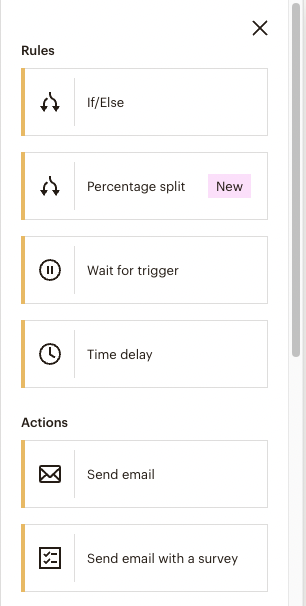
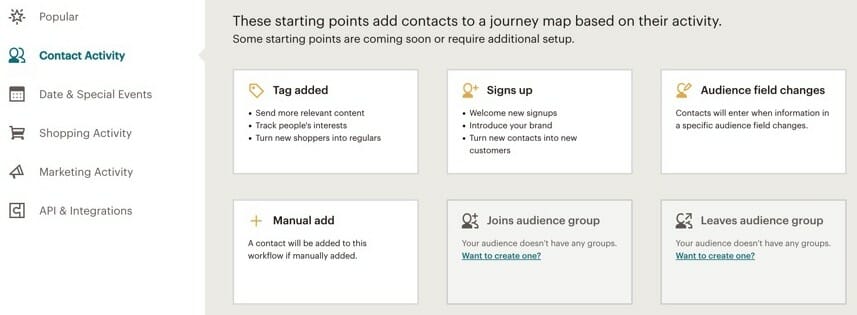
They have a large range of starting points/triggers and you can even use up to three of these in one automation. All up there are 37 options for starting your workflow.
From there you can add a Journey Point. There aren’t as many options here – only four rules (if/else, wait for trigger, time delay and percentage split) and seven actions (send email, group, tag, update contact, etc).
Users can easily enter a sequence multiple times. You just need to tick the box in the automation builder that says ‘Contact repeats journey’.
It’s not easy to see where in an automation a contact is. You can only see how many contacts have started, are in progress and have completed a workflow.
There are over 40 automation templates including things like email tagged customers, re-engaging subscribers and shipping confirmation.
Click here to learn more about MailChimp’s marketing automation features.

ActiveCampaign Marketing Automation
Sending one-off broadcasts is done via the Campaigns section inside ActiveCampaign. The load times are a bit long and there are multiple steps involved, so this isn’t as quick as Mailchimp. However there are tons more tools so there’s definitely a trade off.
Anything that isn’t a one-off broadcast is created inside the automation builder. This means everything from super basic automations up to the most advanced ones are built out using the same tools.
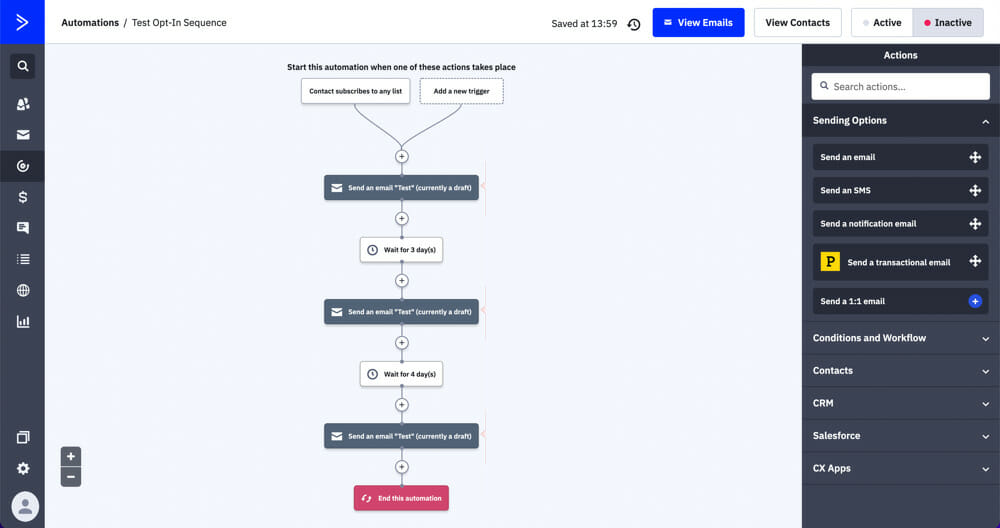
Given you have so many more options, creating a basic automation can take a bit more time but you can end up with much more customized emails and workflows if that’s what you want.
Advanced automation really is where the full power of ActiveCampaign comes in. There are so many options and capabilities. The sky’s the limit when it comes to building out workflows and complex marketing campaigns.
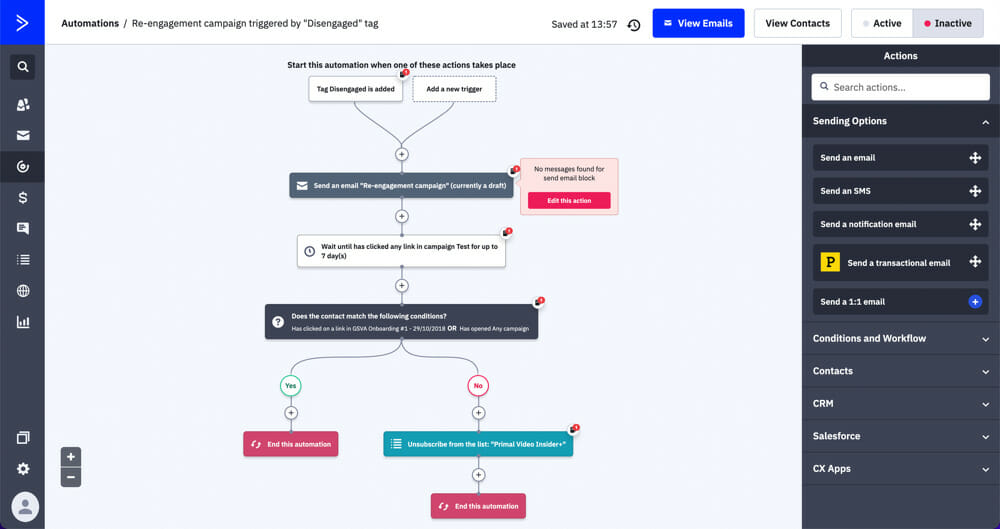
One super useful feature is the Goal action. This allows you to jump a user forward in a workflow once they’ve hit a particular goal or meet a certain criteria.
For example, say you have a user in a sequence and you want them to click a link over the course of four emails. If they click on that link in the first, second or third email, the Goal action will push them forward in the automation so they don’t receive any more emails trying to get them to click the link again. This is an awesome tool to have.

You can start automations without a trigger. This is useful if you want to manually add individual contacts or if you only want contacts to enter the automation after completing a different automation.
There’s a full library of automations with over 20 triggers and around 40 actions. This is a big step up from MC’s four rules and seven actions.
There’s also a huge range of conditions available when segmenting your contacts in the automations.
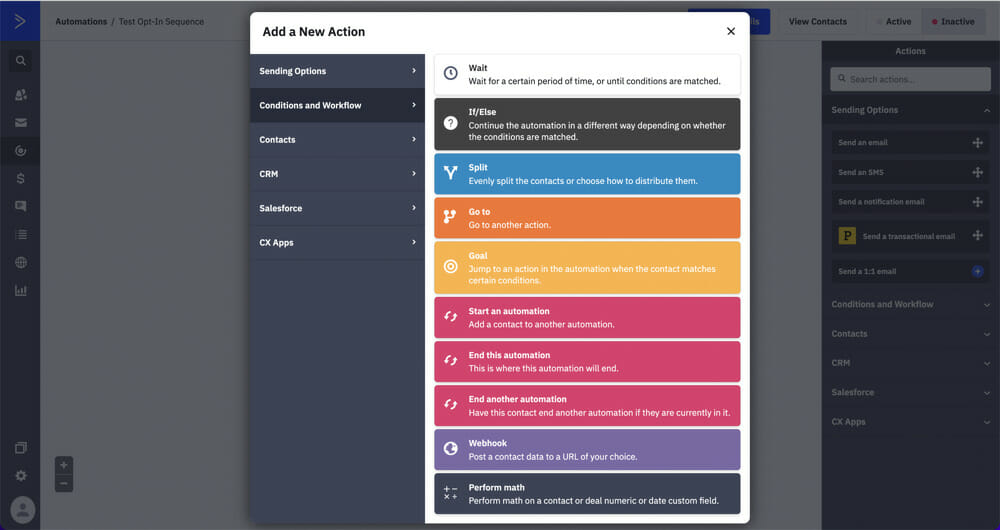
You can go down to specific actions a user has performed such as ‘has clicked a link’, ‘has not clicked a link’, ‘has visited a page’, etc. There’s a ton of options.
There are around 25 automation templates for things like upselling, ecourse delivery and failed billing reminders.
Learn more about ActiveCampaign’s marketing automation tools here.

The Verdict
ActiveCampaign has more advanced automation tools and actions than Mailchimp. It is, after all, one of the most powerful marketing automation software we’ve come across.
However, Mailchimp’s marketing automation isn’t basic – there’s a wide range of tools to help you build out effective workflows. It also has an easier to use and more intuitive automation builder.
This comes down to how advanced you want to get with your marketing and email automation.
Segmentation Comparison
Contact segmentation is incredibly important. It allows you to group your contacts and only send particular emails to the people who are most likely to be interested in them.
Different email marketing services use a range of different segmentation tools. We’ll dive into what combination of tools are used by each email marketing software and analyze how granular these allow you to get with your segmentation.
Mailchimp Segmentation
Lists, segments, custom fields and tags are used to manage contact segmentation. MC call their lists ‘Audiences’ and you can have one, three, five or unlimited depending on which pricing plan you’re on.

However, Mailchimp’s lists aren’t like lists you’d normally see in email marketing software. Usually lists are static and allow contacts to move between different ones as behavior and other factors change.
But each MC list is siloed meaning you can’t manage or move contacts between lists. This really limits the power of using lists and means you need to rely more on tags. It also has a pretty big impact on pricing unfortunately, but we’ll get to that later!

For example, when you go to send an email you have to pick an Audience and then within that audience you can select different tags or segments. This demonstrates how separate the lists are.
Custom segments can be created based on things like personal detail, recent contact activity, personal details and tags. This is a solid feature that allows you to get really granular.
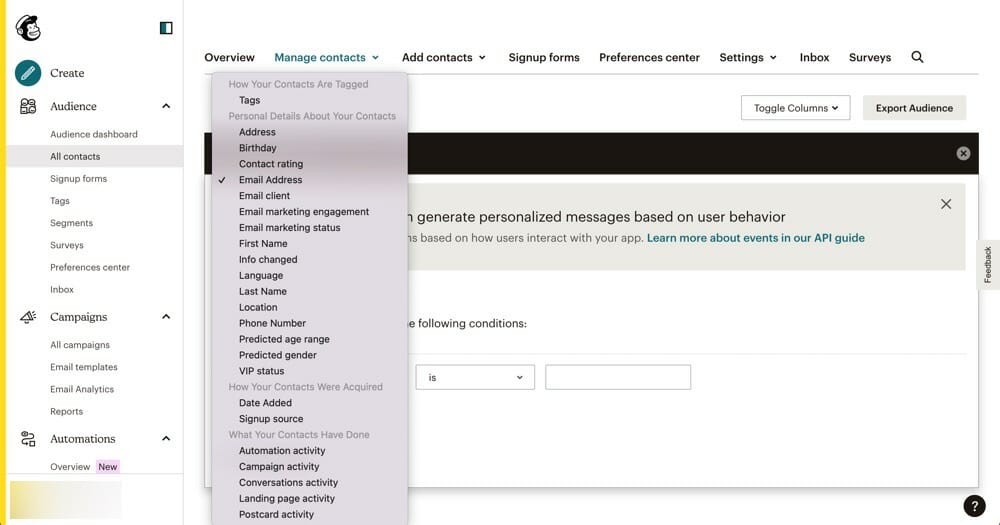
There’s also a Groups feature which is a way to categorize contacts based on their interests and preferences. Contacts can select these groups for themselves (for example in response to questions in signup forms) or you can add them manually.
Overall, there are some decent segmentation tools. However it’s a shame that the lists are static as this makes the process less seamless.
ActiveCampaign Segmentation
In ActiveCampaign you can use lists, custom fields and tags to segment your audience. AC has mobile lists meaning contacts can move between them (unlike Mailchimp), making segmentation cleaner and less clunky. There’s also no limits on how many lists you can have.
The custom fields can be managed in a separate section and each custom field must belong to a field group. This is really powerful as you can add multiple custom fields into each field group, allowing you to get really specific with your segmentation.

Like MC, ActiveCampaign’s custom fields also support flexible data types (e.g. dates).
Tags are useful to have but it’s great that you don’t need to rely on them. Inside this feature you can easily see how many contacts have a certain tag and which automations each tag is a part of.
All of these tools make segmenting your contacts really easy. Contacts are also able to easily subscribe and unsubscribe from different lists based on the type of email they want to receive.
Being able to utilize all of these tools to this level gives you a lot of flexibility and is really powerful.

The Verdict
ActiveCampaign supports really seamless and powerful segmentation. While Mailchimp does have some solid tools, the Audience feature is a bit limiting. Especially since there’s a limit on the number of audiences/lists you can have.
Contact Management Comparison
Some email marketing software have built-in customer relationship management (CRM) tools that allow you to completely manage your customers from within your email platform. Others have very basic contact information and require you to have a third party CRM system.
We’ll take a look at the key features each email marketing service provides for contact management.
Mailchimp Contacts
You can do basic tasks such as add tags, add a VIP, export, unsubscribe or add a note.
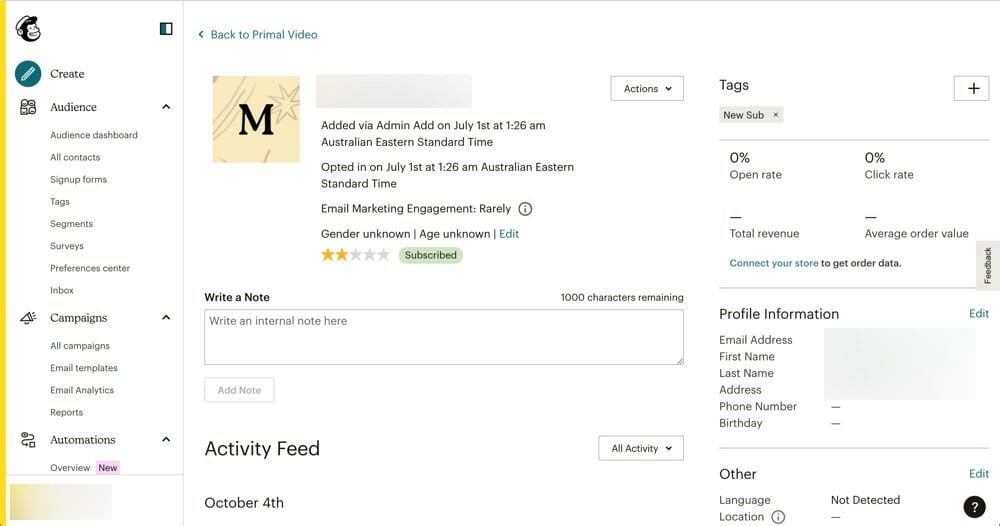
There’s a fairly detailed activity feed that displays information on opens, clicks, ecommerce activity, web engagement, events and survey responses.
Unfortunately you can’t see what automations a subscriber is in from the activity feed or anywhere else in their contact information.
This is definitely a downside as there’s not really any area in MC that you can tell which subscribers are in which automations.
You can email contacts directly from their contact page.

As mentioned in the Segmentation section above, custom fields are not limited to plain text which is powerful.
Contact scoring is supported. Contacts are automatically rated on a scale of one to five.
This rating is based on a 16 point scale that measures contact engagement. You can use this information to send appreciation campaigns and re-engagement campaigns based on how engaged those contacts are.
ActiveCampaign Contacts
Being a CRM as well as an email marketing platform, ActiveCampaign gives you a lot more customer information than most other email marketing platforms. You’re able to get a really comprehensive picture of your audience.
The recent activity feed has a high level of detail including when a contact has entered and completed an automation.
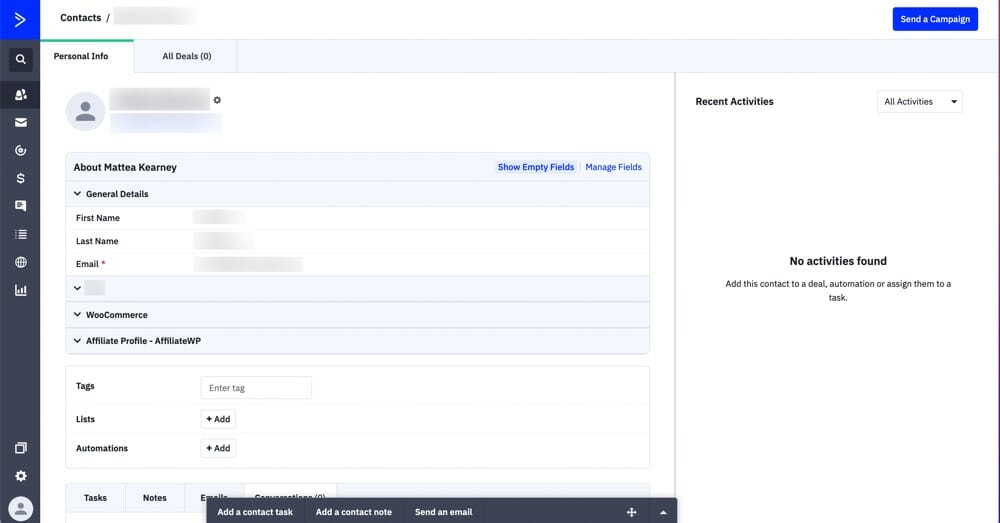
You can manually enter a contact into a list or automation directly from their contact page. You can also email individual contacts, add contact tasks and manage conversations.
Mailchimp also has a feature to manage conversations but this is done in a separate section where inboxes are divided into the Audiences and each email sent counts towards your plan’s send limit.
As mentioned in ActiveCampaign’s Segmentation section above, custom fields aren’t limited to plain text which adds another level of flexibility. Even though CM offers this as well, AC’s custom field tool is a lot more powerful. There’s a separate section for managing custom fields that makes the whole process easy and seamless.
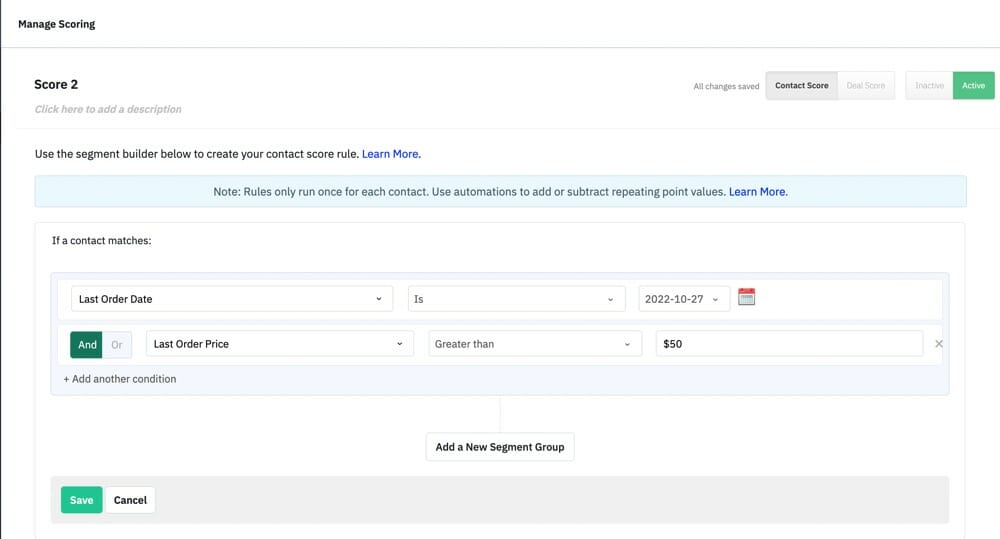
While MC’s contact scoring feature is pre-determined, ActiveCampaign’s contact scoring is much more flexible. You’re able to dictate which conditions are assessed and how a contact is scored making this tool much more relevant to your own business.
The Verdict
Being a CRM tool, ActiveCampaign has a lot more tools for managing contacts. If you don’t want to have a third-party CRM then AC would be a great option. If you only need basic contact management tools or already have a CRM that you love, Mailchimp will get the job done.
A/B Testing Comparison
A/B testing (also known as split testing) is a super powerful tool that allows you to really optimize your content.
Depending on the email marketing service, you could be able to test everything from email subject and content through to send time and sender address. Some tools even allow you to test your email automation workflows.
If you ask us, the more advanced testing available, the better. It’s awesome to be able to know you’re sending out the most popular version of your email.
Mailchimp A/B Testing
You can test the subject line, sender name, email content, images and send time.
A range of different variables can be tested but the number you can test depends on which plan you’re on.
On the Standard Plan, you can test three things at once but only of the same variable e.g. you can test up to three subject lines OR up to three sender names.
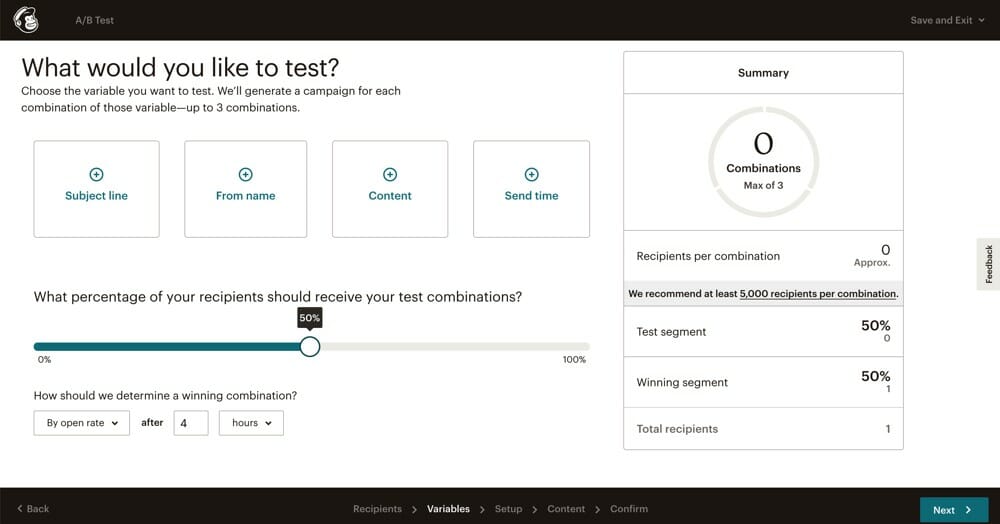
On the Premium Plan you have access to multivariate testing which means you can choose up to three or four variable types and you can create up to 8 variations. For example, you could test two different subject lines and two different email content variations and two different send times.
This is a powerful feature but keep in mind that you usually don’t want to test too many different variables as you’ll have no idea why contacts clicked one over the other.
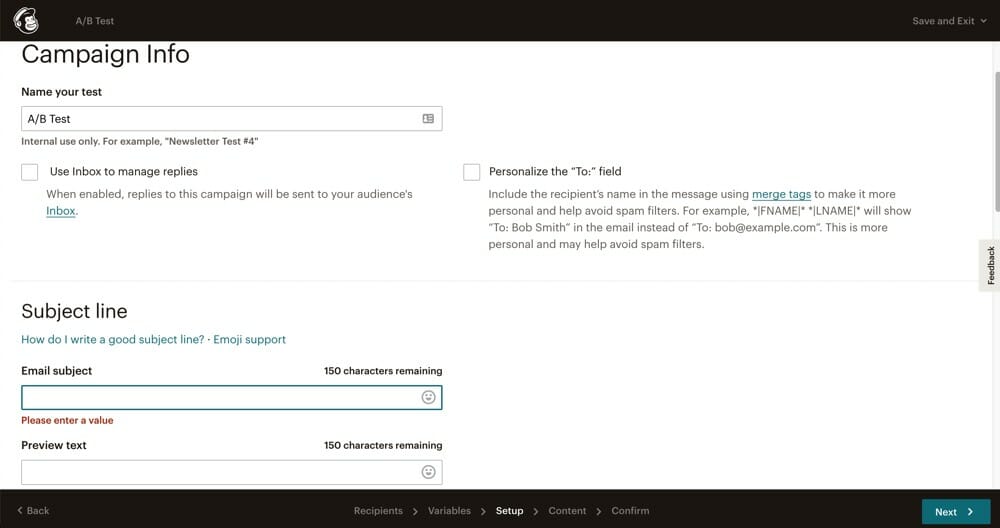
Auto sending to the best performing variable is also supported. You can determine the winner based on open rate, click rate, total revenue or by manual selection.
The percentage of recipients that receive each variable is completely customizable and you can decide how many days or hours the test goes for until the winner is selected.
Learn more about MC’s A/B testing functionalities here.
The new Split feature allows you to split test workflows inside the automation builder too. This gives you the ability to test just about anything: wait times, number of emails, sales team follow ups, etc.
ActiveCampaign A/B Testing
You can test the subject line, sender name, content and images for broadcasts and sequences.
Up to five variables can be tested at once. There’s the option to run the test purely for analytics or you can auto-send to the best performer. The tests can be based on the best click through rate or best open rate.
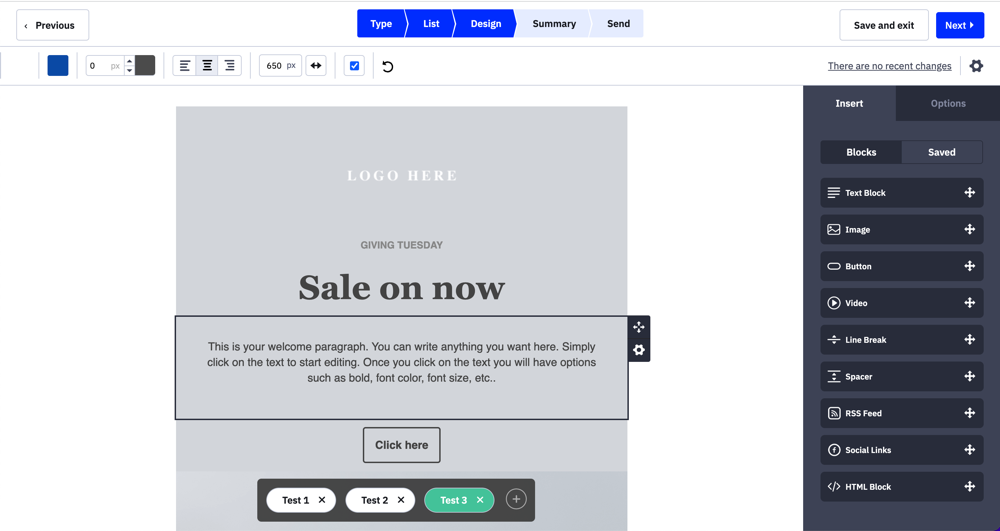
Just like in MC, you can decide your own custom testing and sending ratios meaning you can choose what percentage of your audience will receive each of the test emails.
For example, if you’re testing three different subjects for an email you might send each subject to 10% of the email list. You might decide to wait 5 hours and then send the email subject that has the best open rate to the remaining 70%.
However, currently the broadcast testing feature is only available when using the Classic and HTML editors.
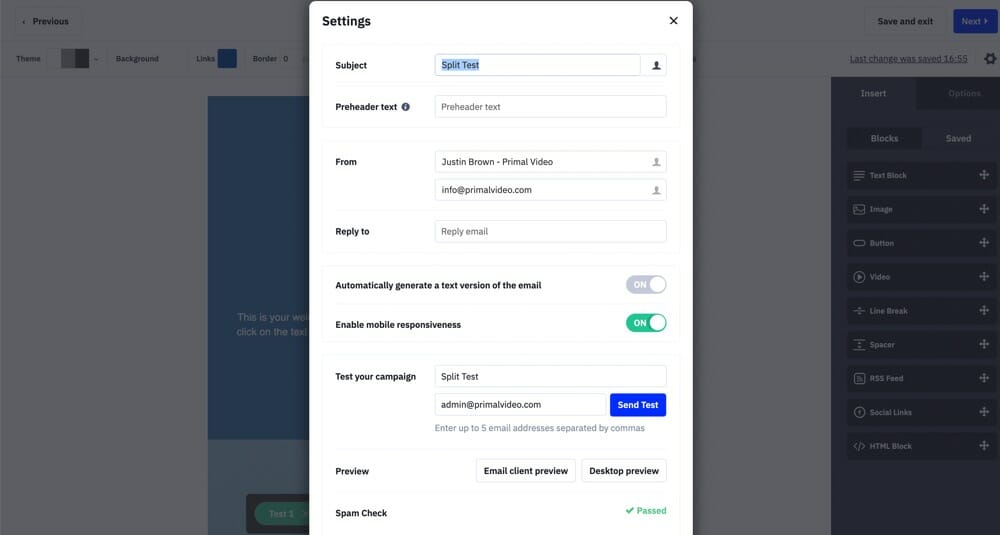
You can learn more about AC’s email A/B testing tools here.
ActiveCampaign also supports split testing automation workflows on their Professional Plan. This allows you to test a bunch of workflow variables like in Mailchimp.
This means you can be really creative with your tests and find the workflow that will get the best outcome for your business.

The Verdict
Both Mailchimp and ActiveCampaign have really powerful split testing features that allow you to make sure you’re sending the email content that’s most likely to get results.
Forms & Landing Pages Comparison
Utilizing landing pages in your marketing campaign is a great way to build your email list AND your business. There are a number of aspects to consider such as the landing page templates, the landing page builder and the signup forms you can use within the page or on your website.
Mailchimp Landing Pages
The landing page builder is pretty much exactly the same as the email builder. It’s a drag and drop editor which gives you a decent amount of flexibility but does leave a bit to be desired.

There’s much more customization than something like ConvertKit but nowhere near as much as ActiveCampaign. For example, you can move blocks up or down but you can’t add them to the sides of other blocks like in AC. There’s limited flexibility.
There are nine landing page templates all of which are pretty basic and don’t look overly exciting, especially when compared to a lot of other software (like GetResponse for example) which have tons of high quality landing page templates.

There’s also no start from scratch option meaning you need to start with one of those templates.
There’s a range of form types including regular sign up form, embedded form, subscriber pop-up, contact form or you can create a form via an integration. However there are no form templates, just one standard option for each form type. Only very basic customization is available.

There is also a very basic website builder. There aren’t any templates to choose from but you can change the layout of each section to suit your desired design. It’s snappy and easy to use – great for beginners or anyone wanting to create a very basic website.
ActiveCampaign Landing Pages
The ActiveCampaign landing page builder allows a really good level of flexibility. There’s a drag and drop editor that allows you to move things around easily. Everything is completely customizable.
You’ll find much more flexibility and features here than in Mailchimp’s builder. For example you can add countdown timers, PayPal links and navigation bars – none of which are available using MC’s landing page builder.
It can feel a little clunky at times but you’ll definitely be able to build out some effective landing pages.

There are over 60 templates available, some of which look outdated but thankfully you’ve got plenty of options to choose from. There’s a start from scratch option if you want to build out your own landing pages.
ActiveCampaign supports inline, pop-up, floating box and floating bar forms that can be built in a separate form builder.
There are no form templates, just a very basic drag and drop form builder. Similar to Mailchimp’s form builder, it’s hard to build out something nice. You’d probably want to link these forms to other opt-ins so they won’t be seen by users.
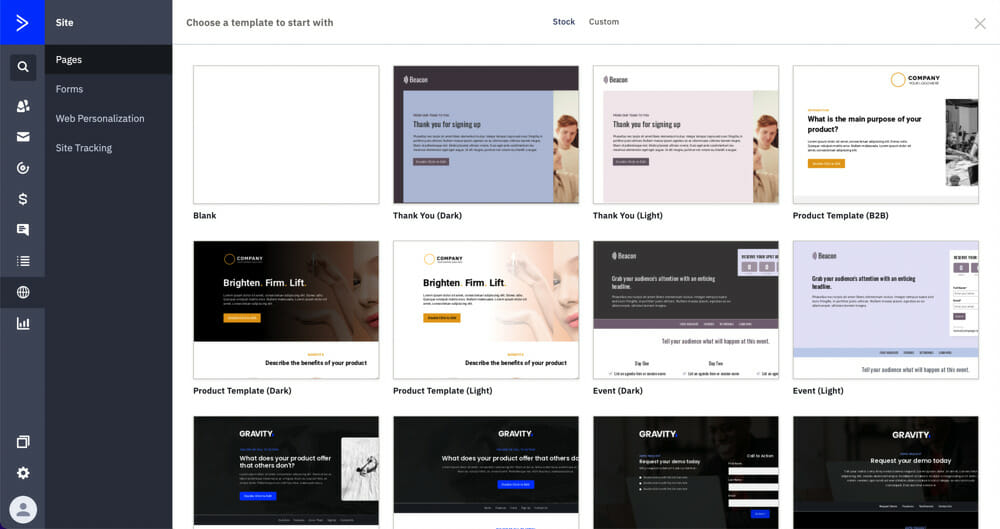
The Verdict
ActiveCampaign has a ton more landing page templates and most of them are of a higher quality than inside Mailchimp. The builder feels smoother and easier to use. There are also more options when it comes to blocks.
Ecommerce Comparison
If you’re an online or ecommerce business, ecommerce features are important! You’ll find that some email marketing platforms support a ton of built-in ecommerce tools and with others you’ll need to rely on integrations.
The right option for you will depend on your particular situation.
For example, if you’re after basic ecommerce tools you’d be able to depend on the built-in options. Whereas if you require advanced ecommerce support, you’re more likely to find what you need by using an external ecommerce provider.
Mailchimp Ecommerce
If you want to utilize these e-commerce tools, you’ll need to jump on one of their Website & Commerce Plans. This is an additional plan on top of the Marketing Platform Plans.

On the Website & Commerce plans you have access to unlimited products, shopping cart, abandoned cart emails, appointment scheduling and can connect your custom domain (only on paid plans).
On top of that, you need to purchase transactional emails if you want the ability to send them. Prices start from $20 for 25,000 emails a month.
You can sell one-time purchases such as e-books, whitepapers, art files and physical products when you connect your existing store.
If you want to offer a monthly or annual subscription you will need to use an integration such as Campaignzee or Chargebee.
If you’re based in the US or UK you can also sell products directly through the MC store. However this feature isn’t available in most countries yet. You need to provide a US or UK-based business address during setup.
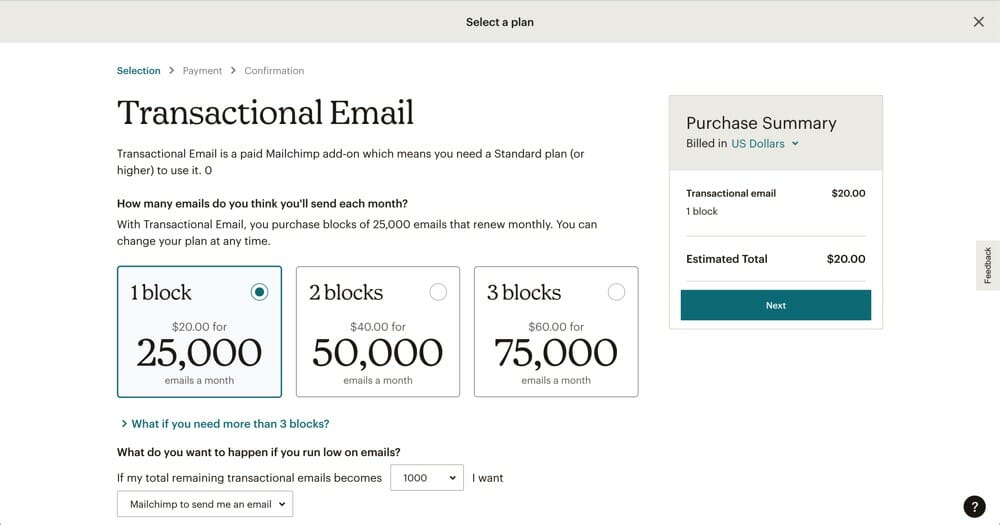
The transaction fee is between 0.5% and 2% depending on which Website & Commerce Plan you’re on (not including the Stripe processing fee).
These ecommerce features are well integrated in the automation builder. There’s a number of ecommerce triggers e.g. buys any product, time since last purchase, abandons cart with specific product, cancellation confirmation and order confirmation.
Click here to find out more about MC’s ecommerce features.
ActiveCampaign Ecommerce
ActiveCampaign doesn’t support ecommerce out of the box. However, it does integrate with other e-commerce platforms quite strongly.
This means if you already have an existing online store (though Shopify or WooCommerce, for example) then you can bring in that sales and customer data, and incorporate it into your automations.

While MC does have built-in ecommerce, the tools are a bit restrictive. If you want more advanced or customized ecommerce, you’d be better off using AC in conjunction with a more professional external ecommerce provider.
This method would be especially powerful if you have access to the Ecommerce dashboard which is available on the Plus Plan and higher.
It provides metrics on where your subscribers are in the customer journey and insights into how you can increase sales. The dashboard integrates with BigCommerce, Shopify, WooCommerce, Magento and Square.
On top of that, it seems like ActiveCampaign is prioritizing the addition of more built-in ecommerce features as well.

They’ve announced that an ecommerce product block will be released for the Email Builder. This will display product recommendations in emails based on user behavior (e.g. previous browsing or purchase history).
The ability to send transactional emails via Postmark through the automation builder has also recently been added.
The Verdict
Mailchimp has some solid built-in ecommerce tools but you will need to purchase an additional subscription to access them. If you’re based in the US or UK you could rely solely on these tools for your ecommerce needs if you only require basic features, however if you’re outside of those countries you’ll need to rely on integrations.
ActiveCampaign’s power lies in the metrics and insights it offers. You will need to rely on integrations but chances are you’d need to do with Mailchimp as well.
The right one for you will depend on what type of ecommerce tools you require from your email marketing service.
Integrations Comparison
Having a solid number of direct integrations inside your email marketing platform allows you to access a ton of functionalities that aren’t built-in to the software. This is really powerful.
Some email marketing software rely on Zapier for their integrations rather than having native or direct ones. We always keep an eye out for this as native integrations are more seamless and easier to manage.
Mailchimp Integrations
There are 313 direct integrations available including LiveChat, SimpleTexting, Zendesk, WordPress, LinkedIn, Typeform, SurveyMonkey, Patreon and Canva to name a few. Plus there’s Zapier if you need it for anything that’s not directly integrated.
Check out the complete list of Mailchimp’s integrations here.

ActiveCampaign Integrations
There’s around 70 native integrations through ActiveCampaign. This includes Bonjoro, Facebook, Google Calendar & Analytics, PayPal, Shopify and Survey Monkey. You most likely won’t need to rely on Zapier but it’s good to know it’s there for anything that ActiveCampaign doesn’t support.
You can browse through the complete list of ActiveCampaign’s integrations here.
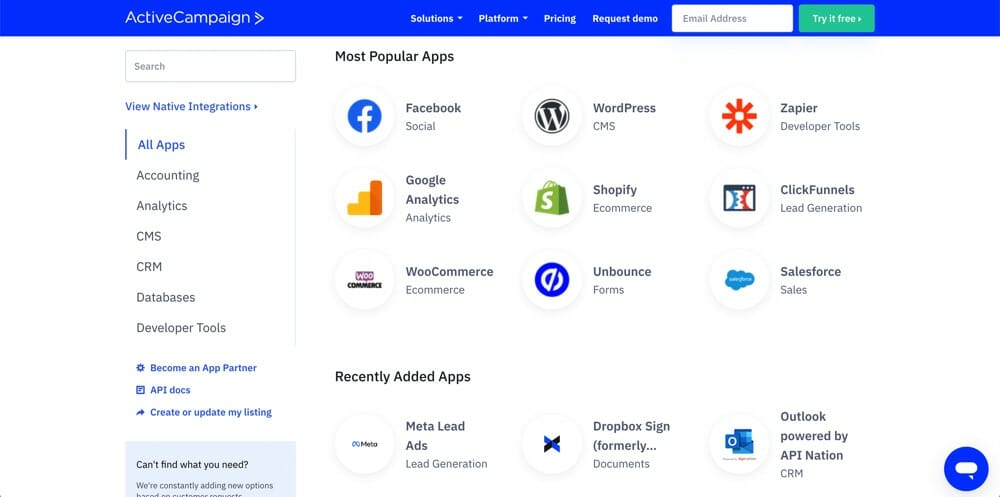
The Verdict
Both of these email marketing platforms offer significantly more direct integrations than their competitors. Mailchimp definitely comes out on top for this one but ActiveCampaign still offers a large number of integrations and should meet the needs of most users.
Reporting & Analytics Comparison
Having access to reporting and analytics from your email marketing campaigns allows you to analyze your results and hopefully improve on your next one.
The level of reporting you require really comes down to personal preference. For most people, basic reporting will tell you everything you need to know. But if you’re a numbers person, it’s great to have access to more advanced analytics.
Mailchimp Reporting & Analytics
You can access open rates, click rates, unsubscribes, bounce rates and a click heatmap for each campaign.
There’s also information on your top clicked links, how your campaign performed in context to similar businesses, 24 hour performance graph, top locations by opens and social performance e.g. tweets.

A new reporting feature is the Content Optimizer which rates whether best practices were met e.g. skimmability, text & visuals, links & CTAs and typography. They also give suggested improvements based on those findings for your next email. This is pretty basic but could be helpful for beginners.
In terms of ecommerce reporting, you can see how many orders were made, the average order revenue and total revenue for each email.

You can also access overall email analytics which displays performance across all campaigns for a specified time frame.
Overall, these are great reporting features that should be advanced enough to suit most business owners.
ActiveCampaign Reporting & Analytics
The reporting available inside ActiveCampaign is next level. It’s seriously advanced (albeit a bit clunky!).
For each email you can access forwards, bounce rates, hourly open trend graphs and more.
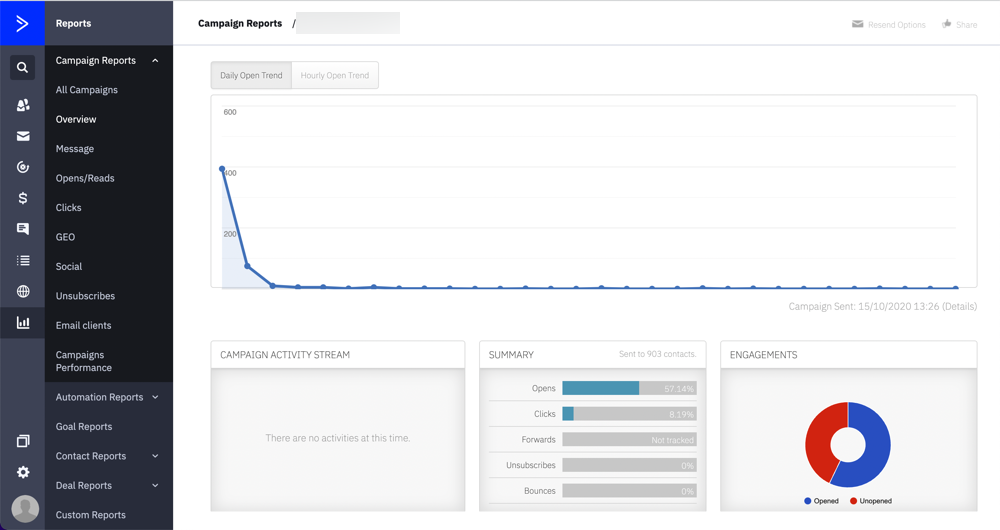
Automation reporting, which is available even on the Lite Plan, allows you to see a ton of data on your automations.
This includes how many contacts have entered the automation, the total sends, unique opens, total unsubscribes, etc. over a specified period of time. This allows you to really quickly measure the effectiveness of your automations at a glance.
You can also get analytics on campaigns, goals, contacts, deals and chat conversations.
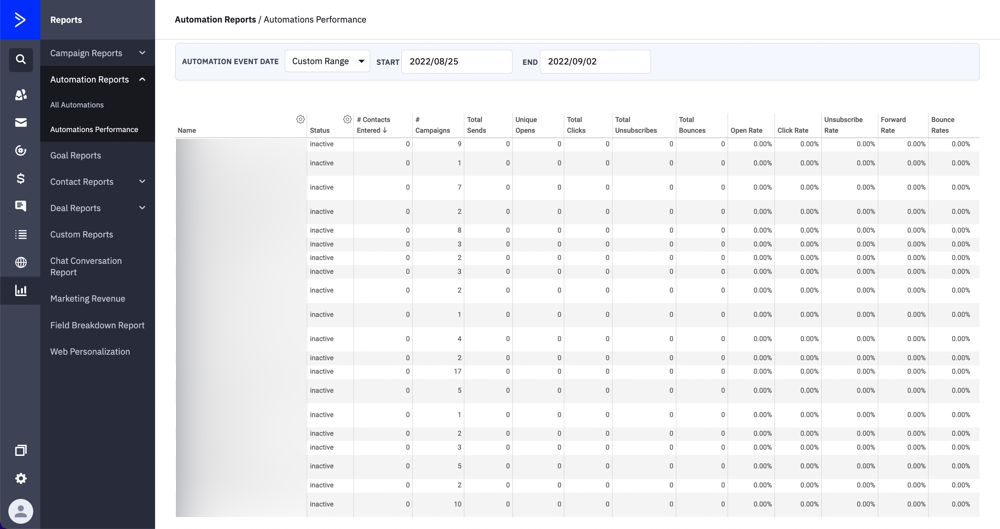
Plus if you want to get even more specific, you can create custom reports on the Enterprise Plan.
This level of reporting allows you to really comprehensively measure the effectiveness of your email marketing strategy.
The Verdict
Mailchimp’s reporting and analytics features cover the basics and then some. If you don’t require advanced reporting, this will absolutely get the job done. Some of the features seem a bit gimmicky (e.g. the Content Optimizer) but they might come in handy for some people.
While it can be clunky to navigate, ActiveCampaign offers really comprehensive reporting that allows you to get creative and customize really specific reports. If you want access to a high level of analytics, this is a great option.
This depends on what level of reporting you want to be able to access.
Deliverability Comparison
Email deliverability is the number of emails that actually make it into your subscribers inbox. The emails you send can sometimes end up in the spam folder or simply not arrive at all.
Some email marketing software have higher email delivery rates than others. It’s a difficult thing to accurately assess and it’s constantly changing. We’re relying on what we deem a reliable source for this data: emaildeliverabilityreport.com.
Mailchimp Deliverability
According to Email Deliverability Report’s Mailchimp report, the average delivery rate is 80.09%, with 16.08% going to spam and 3.83% not reaching the recipient.
ActiveCampaign Deliverability
According to Email Deliverability Report’s ActiveCampaign report, the average delivery rate is 86.80%, with 10.24% going to spam and 2.95% not reaching the recipient.
The Verdict
As we mentioned earlier, the email deliverability an email marketing tool achieves is constantly changing and hard to measure. Having said that, Email Report Deliverability currently ranks ActiveCampaign higher than Mailchimp for this category.
Other Noteworthy Features
There are some other noteworthy key features and marketing tools that don’t fit into the usual categories.
Non-Email Communications
Web push notifications are notifications that can be sent to a user’s web browser after they’ve subscribed and given permission. Website live chat and SMS marketing are two additional non-email communications that prove super powerful in marketing campaigns.
Inside Mailchimp, push notifications and live chat can only be achieved using integrations – it doesn’t have these features built in. Built-in SMS marketing is only available for users in the US and for the purposes of managing appointments or a store. Alternatively, there are also SMS marketing integrations available.
ActiveCampaign provides direct access to website live chat and SMS marketing. However SMS marketing is only available on the Plus Plan or higher. Web push notifications are supported via integrations.
These features all integrate well with ActiveCampaign’s automation builder.

Tracking
Site tracking is a super powerful tool that collects user activity across your web pages. This means you can get insight into what contacts are doing on your website and create personalized experiences for individuals based on how they interact.
Custom events are another way to track your user’s activity and market to them accordingly. They’re actions taken by users on your site. You’ll see an activity feed of user’s events and can trigger workflows when certain events occur.
Mailchimp and ActiveCampaign both offer site tracking and custom event tracking.
Learn more about Mailchimp’s site tracking and custom event tracking tools here.
Check out ActiveCampaign’s site tracking and custom event tracking tools here.
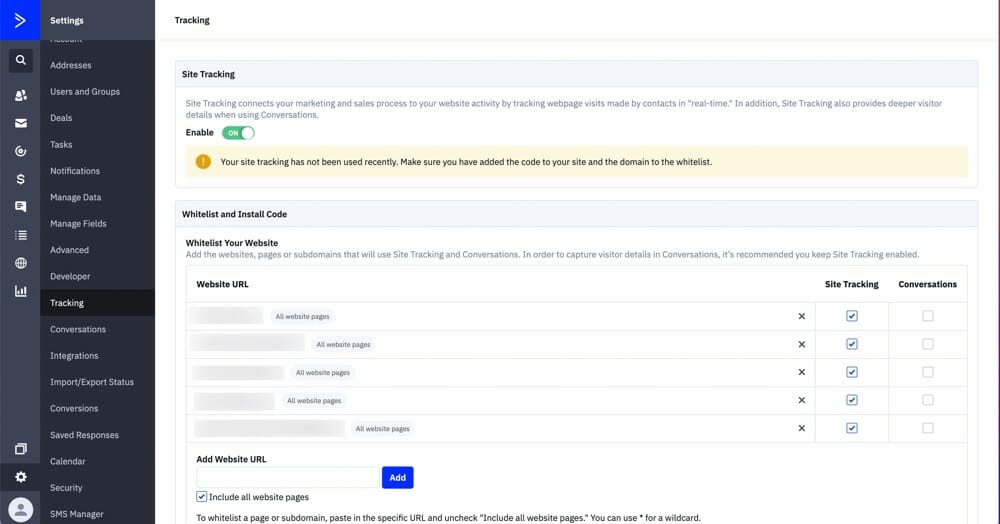
The Verdict
ActiveCampaign provides direct access to one or two more of these features than Mailchimp but this doesn’t make a big difference. Overall, it’s awesome that both email marketing software support these powerful tools.
Customer Support Comparison
This is another important aspect of choosing an email marketing software. If something goes wrong, it’s good to know whether customer support will be there to help.
We’ll also cover whether the platforms offer migration, a community and a knowledge base to help you find your way around the software.
Mailchimp Customer Support
Customer support includes email, live chat (available 24/7) and phone support if you’re on the Premium Plan.
There’s no migration offered on any plans.
Mailchimp has a TrustPilot rating of 1.4/5 star rating. They received one star reviews from 77% of reviewers. Most of the bad reviews claim bad customer service, falling delivery rates or accounts being suspended for violating policy for unknown reasons and no explanations.
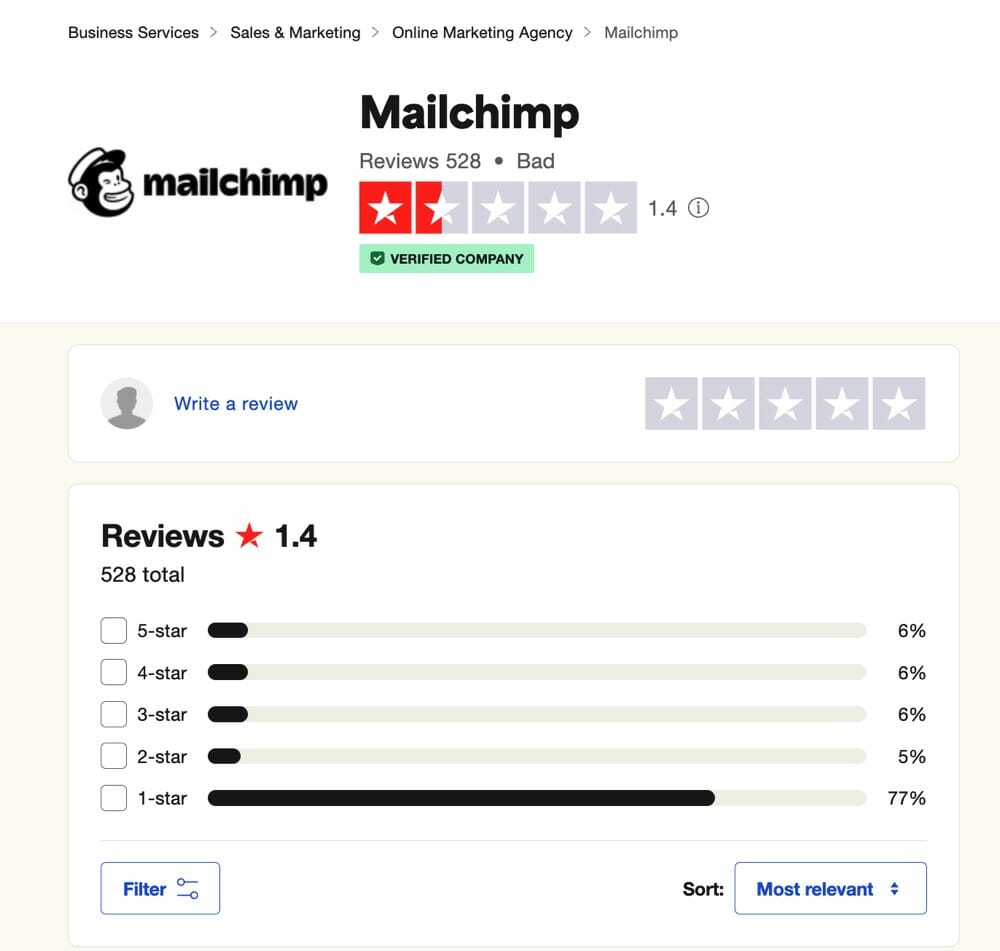
There’s a Mailchimp community for freelancers and agencies. However this isn’t so much an interactive community as it is a place where you can find articles and information. They also hold relevant events e.g How To Build a Growth Marketing Strategy.
There are guides and tutorials which offer pretty much everything you need to know to effectively use MC. There are also interactive suggestions when you’re going through tools/steps for the first which are useful for beginners.

ActiveCampaign Customer Support
Live chat is available Monday – Thursday from 9am – 11pm and Friday from 9am – 4:30pm, CST. You can also request help via support ticket, email and if you’re on the Enterprise Plan via phone.
They offer free migration for any number of subscribers. The migration includes automations, email templates, forms, landing pages, lists, tags and custom fields.
Very shortly after signing up you’ll receive a phone call plus an email from ActiveCampaign offering a free one on one call to help you get started as well as a demo video with some easy steps to get set up.

They have a 4/5 star rating from 578 reviews on Trustpilot. Over 65% rated them 5 stars. In terms of customer service, the majority of users report great support while a handful complain of slow wait times or inadequate responses.
There is an ActiveCampaign community but it isn’t very active. Some of the questions are years old and haven’t been answered. Thankfully there are loads of educational articles on the website which answer most of the questions you’d need answers to.
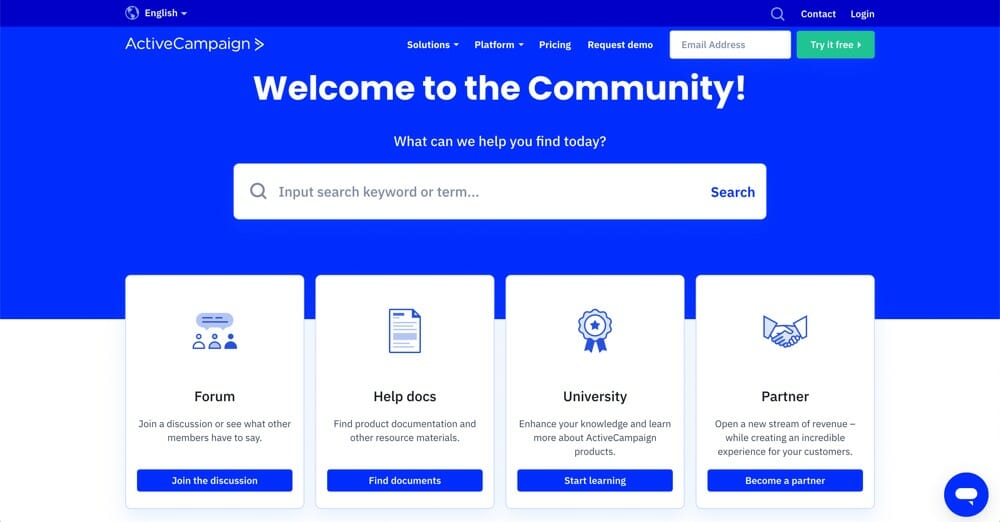
The Verdict
ActiveCampaign comes out much further ahead than Mailchimp in terms of customer support. They have a significantly better rating on TrustPilot, offer free migration and you’ll receive check-ins from AC staff to help you settle in.
The only point that Mailchimp proves better is that they offer 24/7 chat but given the incredibly low rating they received for customer service on TrustPilot, we wouldn’t necessarily say that’s a good thing.
Ease Of Use Comparison
Taking into account the ease of use of an email marketing software means there won’t be any nasty surprises when you jump in.
The last thing you want is to open up the platform only to realize there’s a massive learning curve and it’ll take hours to get up to speed (unless that’s something you were aware of!).
We’ve rated four common tasks on how easy they are to complete using each email marketing software.
Mailchimp Ease Of Use
The learning curve is super basic. Everything is clearly laid out and makes sense. The process is fast and the interface is modern and visually appealing. Everything feels cohesive and runs smoothly.
| Ease of Performing Key Tasks | Comments |
| Send a broadcast ⭐⭐⭐⭐ | Quick and intuitive. Easy for beginners to dive into email creation and understand what to do and how to do it. |
| Setup basic automation ⭐⭐⭐⭐ | This is done in the Customer Journey Builder. You can really easily build out basic automations. It’s not as quick & easy as something like ConvertKit’s sequence builder but it’s still super easy to set up. |
| Setup complex automation ⭐⭐⭐ | There aren’t as many advanced automation features here. Basic if/then logic is available but for doing things like Goals you’d need to use a workaround using tags. |
| Manage & update contacts ⭐⭐⭐ | It’s easy to manage contacts but it’s also quite basic. This is fine, it just means you’ll likely need a different tool for your CRM. |
ActiveCampaign Ease Of Use
Because ActiveCampaign has so many advanced features, it’s not overly beginner-friendly. There’s understandably a bit of a learning curve to figure out how everything works. It’s not as intuitive as some other email marketing services.
| Ease of Performing Key Tasks | Comments |
| Send a broadcast ⭐⭐⭐ | Going through the steps to build out a broadcast is a bit more time consuming than Mailchimp. But it’s still straightforward and easy to jump into. |
| Setup basic automation ⭐⭐⭐⭐ | Building out basic automations is fast and user-friendly. It can be a bit quicker in less advanced software but the process is still straightforward. |
| Setup complex automation ⭐⭐⭐⭐ | This is super powerful but it can take longer to get the hang of due to all the options and functionalities. The templates would come in handy if you’re just starting out. |
| Manage & update contacts ⭐⭐⭐⭐⭐ | There are a ton of CRM features making it really easy to manage your contacts. |
The Verdict
Mailchimp comes out ahead for ease of use if you just want access to more basic features.
If you want to access advanced marketing automation features, for example, this will be easier inside ActiveCampaign as workarounds won’t be required.
Pricing ($USD/monthly) Comparison
Of course, price is another significant factor when it comes to the right email marketing solution for your business.
It’s always useful if the software offers a free plan as well, but keep in mind that these are usually limited to less than 1,000 contacts and have a number of gated features.
Mailchimp Pricing
The first thing you need to be aware of with Mailchimp’s pricing is that you will be billed for unsubscribed users and non-subscribed contacts. Non-subscribed contacts are users who have interacted with your online store but haven’t opted in to your email marketing campaigns.
Additionally, if a contact is in multiple audiences you will be charged for them multiple times. For example, if [email protected] was a contact in Audience 1, Audience 2 and Audience 3, they would be counted as 3 separate contacts and you would be charged 3 times.
These billing structures are seen in very few email marketing software so it could be a deterrent for some people.
There’s also a maximum monthly email send. For example, on the Standard Plan, the email limit is 12x your contact list. So if you have 10,000 contacts you can send 120,000 emails per month. You will incur extra fees if you exceed this number.
In terms of the pricing plans, there’s a Free Plan available for under 500 contacts. You have access to pretty much all basic features on this Free plan so if you have a small list this would be a great way to get started. It’s a ‘free forever’ plan so you don’t need to worry about future price hikes.
While this is a great option, most people will want to jump on the Standard Plan. On this plan you gain access to five contact lists and incredibly useful automation features such as split automations, multiple starting points and automation templates.
If you want to see what’s offered on the other plans, you can check them out here.
You can have up to 5 users on the Standard plan.
If you want to utilize MC’s ecommerce features, you’ll likely also want to purchase one of the Website & Commerce Plans. This is an additional plan that you can use independently or alongside one of the marketing platform plans we mentioned above.
Just like the above marketing platform plans, there’s a Free Plan for less than 500 contacts and the price goes up according to how many contacts you have and how small you want the transaction fee to be.
There’s no annual discount available on any of Mailchimp’s plans.
| Number of subscribers | 1,500 | 10,000 | 100,000 |
| Price ($USD/month) | $59 | $115 | $605 |
ActiveCampaign Pricing
There’s no free plan available with ActiveCampaign. The cheapest option is $9/month for 500 subscribers on the Lite Plan.
It’s important to note that ActiveCampaign recently updated their pricing model. Previously, an ActiveCampaign subscription included both email marketing and CRM related tools.
Now, these tools have been divided into two different suites:
- ActiveCampaign for Marketing – Email Marketing & Automations
- ActiveCampaign for Sales – CRM & Sales Automation
So similarly to Mailchimp, if you want to utilize email marketing and sales tools, you will need to purchase a bundle of both plans. This makes ActiveCampaign quite an expensive option.
To get access to all the super powerful email marketing tools such as CRM features, landing pages and conditional content, we’d recommend the Plus Plan bundle. You can check out the pricing for this bundle in the table below.
Find out which plan offers the features you need here.
Up to five users are allowed on the Plus Plan.
You can send unlimited emails on all plans until you reach 300,000 email subscribers (then the limit becomes 10x your subscriber list).
| Number of subscribers | 1,000 | 10,000 | 100,000 |
| Price ($USD/month) | $116 | $333 | $1,145 |
| When billed annually/month | $92 | $266 | $916 |
Reviewer’s Recommendation: Which Has The Best Email Marketing Services?
Both of these email marketing platforms have their own strengths and weaknesses. Mailchimp and ActiveCampaign are solid tools that will enable you to build successful email marketing campaigns that help grow your business.
You could comfortably utilize either of these tools for your email marketing. So when it comes to Mailchimp vs ActiveCampaign, which one should you choose?
Mailchimp is an easy to use platform for beginners. The platform is fast, intuitive and aesthetically pleasing.
If things like super customizable split testing, tons of high quality email templates, a massive number of direct integrations and a super intuitive user interface sound up your alley, then Mailchimp is definitely worth checking out.
Want to try it out?
ActiveCampaign can be harder for beginners to get the hang of. But if your aim is to grow your business with email marketing automation, it’s worth investing the time to learn it.
If you want the ability to access advanced automations, high quality CRM-related features, and impressive reporting functionalities, then ActiveCampaign is ticking the boxes.
Sound like this could be the email marketing software for you?

